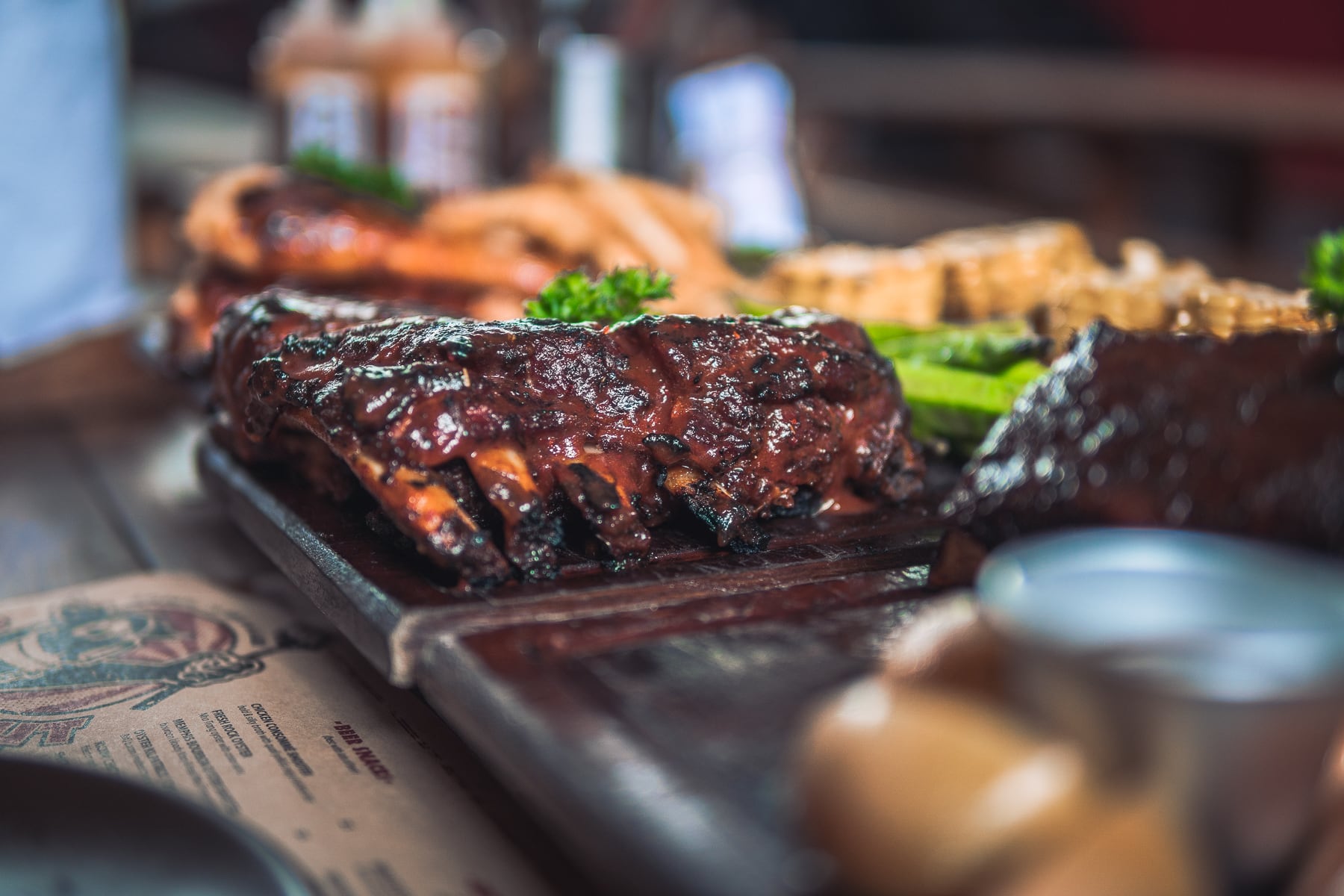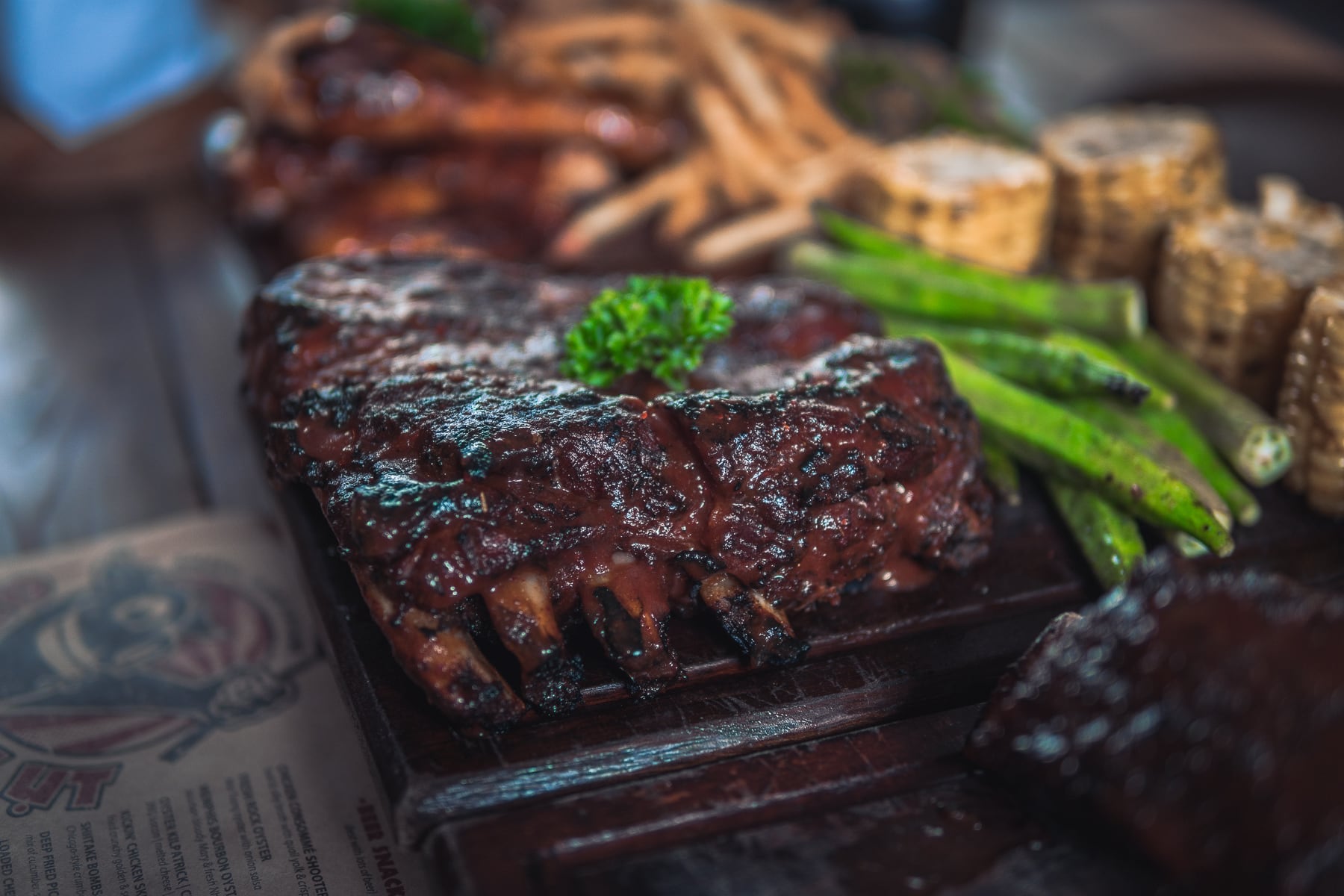“Barbecue means a different thing to different people. But to us, barbecue means low and slow temperatures from organic heat sources, indirect cooking methods…and smoke,” says Quan Ut Ut’s co-founder and pitmaster Mark Gustafson. “And there’s no wrong way to do it. It’s just your way.”
Barbeque takes innumerable forms—and everyone has their own idea about what “good” barbecue is. CNN defined it as involving “slabs of meat cooking for hours—in a grill, in a smoker, or maybe in the ground.” And journalist Claire Suddath from Time said that barbecue is “cooked over indirect heat—usually a fire—for a really long time (sometimes for as many as 18 hours).”

For the team at Quan Ut Ut, the most essential component to crafting that insatiable pile of tender juicy meat is using smoke to infuse the flavors of local ingredients like sugarcane and cacao husks. “It’s not just grilling,” Mark smiles.

In order to learn more about Gustafson’s amalgamated take on barbecue, we headed over to one of their three locations at 60 Truong Sa in Ho Chi Minh City. There, Mark curated four localized ways to prepare barbecue in their custom-built inox smoker, an invention of Gustafson’s own design.
Quan Ut Ut’s curated guide to smoking barbeque

“All the meat at Quan Ut Ut is cooked at 105 degrees celsius. We smoke the meat, then we cover it and roast it so it’s nice and hot.” And items like the cashew smoked pork ribs, pineapple smoked lamb shoulder, and sugarcane smoked chicken all serve as testament to Gustafson’s diverse style of smoking.

“There’s so many variables in the way you can use smoke…it’s never-ending. That’s why I call it the last exotic spice,” Gustafson laughs. During our visit, he’s taking us step-by-step through Quan Ut Ut’s unique smoking process in order to help us understand how the restaurant is taking leftover raw materials and using them to craft some of the best barbecue in the eastern hemisphere.
Step 1: Apply a dry rub

“Before we smoke our meat we dry rub the outside with our own spice blend. It’s similar to a Memphis-style dry rub, but actually it’s a blend of Midwest recipes including St. Louis and Kansas styles. I cherry picked all my favorite kinds. In a way, dry rubs are America’s rendition of curry,” he explains.
Like a brining agent, dry rubs usually consist of two flavors—salty and sweet. Quan Ut Ut’s in-house rub is a mixture of onion, garlic, paprika, cayenne, oregano, and a few other secret ingredients. For the beef short ribs, they add cacao powder to the recipe. “After the spice blend is applied, the meat is left to sit in the rub for 45 minutes before it’s smoked. That allows all those flavors to penetrate the meat. We have it down to science.”
Step 2: Smoke it low and slow

“The meat only becomes porous and open when you smoke it at the right temperature. For us, 105 degrees celsius is the “sweet spot”. When you go for a jog and you start to sweat, your veins become dilated—that’s exactly what you’re doing to the meat in the smoke chamber,” Mark tells us.
Aside from their custom-built smokers topped with “non la” covered vents, stainless steel racks—normally used for drying plates—are repurposed for Quan Ut Ut’s anomalous style of barbecue. Rather than laying slabs of meat flat, Gustafson’s team opt to smoke their ribs vertically.
“The racks provide an air gap so the smoke from the fire box is able to penetrate all sides of the ribs equally,” Mark demonstrates as we watch his team load the smoker. “This method also allows us to control exactly how much flavor the meat will have. The secret is in all of these small details.”

“Smoke can taste like caramelized vanilla. It can be fruity, raisiny, sweet, and it can even be reminiscent of coffee. There’s no end to what it can be,” Mark says.
How long the meat is smoked for is one of the most important parts of the process. Quan Ut Ut smokes their meat for one- to two-and-a-half hours, and compared to many others in the barbecue business, they use lower temperatures. “Cooking at higher temperatures will sear the meat, locking out most of the flavors,” Mark explains. Another benefit of “low and slow” is that it allows the meat to retain moisture keeping the texture soft and tender.
Step 3: Let it cool down

Presenting that perfectly punctuated pile of meat requires more than smoking. There’s a cool-down stage. It’s important that most of the barbecued meat is put in a covered pan after the smoking—this breaks down any remaining connective tissue. “It comes out of the smoker and we let the meat marinate in its own juices at 90 degrees celsius for 2 to 3 hours,” Mark clarifies. “At this point the rub becomes wet. When the moisture is drying off it cools the meat.”
Step 4: Caramelize the bark

“The final steps are to cover it, roast it, and finish it. This is how we get the barbecue to come off the bone with a gentle tug. If it falls off easily, you’ve cooked it too long,” Mark shakes his head. Roasting the meat for an additional two minutes caramelizes the sugar which creates a bark—or crispy outer finish—before it’s flipped and hit with a another dose of rub and a range of homemade barbecue sauces. When the open flame kisses those herbs and spices it creates that smoky flavor.“
Every part of the process is about the flavor. When you hit it with a little rub on the outside you get those tasty little bits from the thyme and oregano. It gives the meat that beautiful tasty char,” Mark says. Step four is the marriage between the rub and the sauce. “It’s the point where all the different flavors come together.”
Our hand-selected favorites: Four-to-try
#1. Cashew smoked pork ribs

These giant signature pork ribs are slow smoked in cashew shell fragments with a Memphis-style dry rub. With nutty and vanilla notes, this smoky, succulent dish is topped off with a swath of Quan Ut Ut’s tangy but mild in-house St. Louis barbecue sauce. For the side dish, we recommend the Southwest cornbread with honey butter and lightly seasoned grilled okra.
#2. Sugarcane smoked chicken

The farm-fresh chicken is split in half and doused with a dry rub which includes onion, garlic, paprika, oregano, thyme, and other undisclosed special spices and herbs. Next, it’s smoked and roasted over coals and sugarcane wood chips before it’s smothered with a sweet fish sauce glaze. For your sides, go for the fresh green beans sauteed in butter and cajun seasoned fries.
#3. Cacao smoked beef short ribs

This is where a trifecta of Maison Marou chocolate meets 500 grams of tender, toasty beef short ribs. With a cacao powder dry rub, cacao husk smoke, and a healthy brush of sweet and roasty cacao barbecue sauce, this on-the-bone specialty item is the first of its kind. We suggest pairing it with Quan Ut Ut’s homemade potato salad tossed with Alabama white barbeque sauce.
#4. Pineapple smoked lamb shoulder

The lamb is brined for 12 hours in a mixture with the same malt grain their business partners at BiaCraft use to make their craft beer. Next the lamb shoulder is slowly smoked over pineapple skins and roasted until it has a sweet caramelized finish. It’s served with a stack of warm tortillas alongside pineapple salsa, pickled beets, and sour cream.
Related Content:
[Article] The Anatomy Of A Dish: BiaCraft’s Jonah Falcondog Foursome
[Video] Vietnamese Food From North To South: Taking The World Beyond Pho

